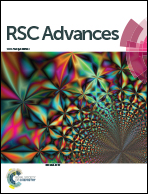Reversible photoluminescence switching behavior and luminescence thermochromism of copper(I) halide cluster coordination polymers†
Abstract
Two novel coordination polymers [Cu3I4(C16H32N4)]·ClO4 (1) and [Cu6I6Br2(C16H32N4)(CH3CN)2] (2) (C16H32N4·2Br− = 4-Aza-1-azoniabicyclo-[2.2.2]octane, 1,1′-(1,4-butanediyl)bis-dibromide) have been synthesized under solvothermal conditions. At room temperature, compounds 1 (Φ = 46.2%) and 2 (Φ = 26.62%) show strong photoluminescence in solid state. At low temperature, compound 1 displays obvious thermochromic luminescence while compound 2 has no obvious change which can be observed by naked eye. However, compound 2 displays a interesting phenomenon. The luminescence of compound 2 is reversible when the coordinated CH3CN molecules in structure are removed by heat and recovered from acetonitrile solvent.


 Please wait while we load your content...
Please wait while we load your content...